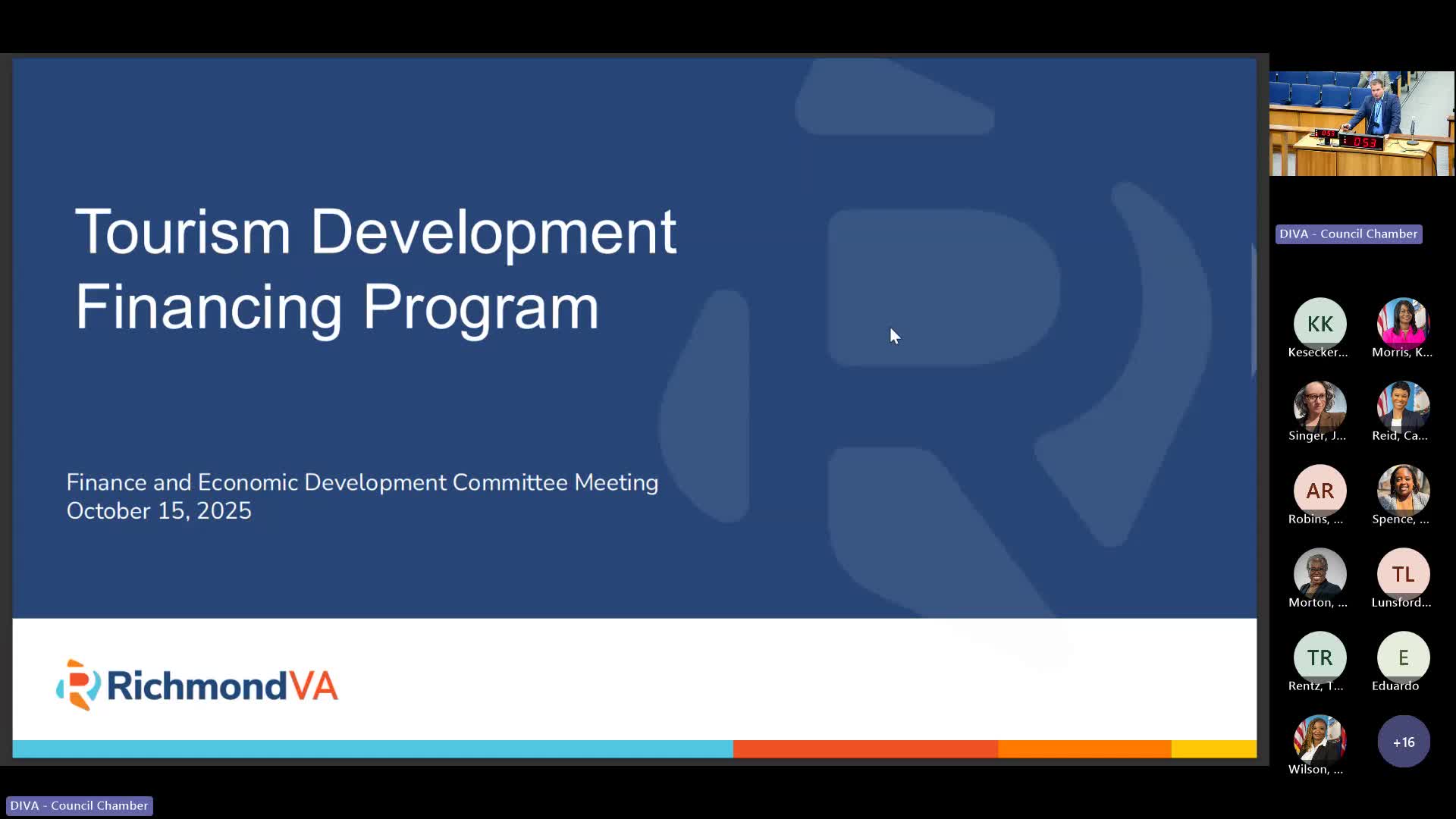Committee backs two Scott’s Addition-area tourism projects using state tourism-development gap financing
October 16, 2025 | Richmond City (Independent City), Virginia
This article was created by AI summarizing key points discussed. AI makes mistakes, so for full details and context, please refer to the video of the full meeting. Please report any errors so we can fix them. Report an error »

The Richmond City Council finance committee voted to forward two ordinances to council that would allow two Scott’s Addition–area hotel projects to participate in the Virginia Tourism Corporation’s Tourism Development Financing Program (TDFP). Both projects must still clear final state underwriting and approvals.
Matt Welch of the Department of Economic Development presented the state program and project details. The TDFP is gap financing that uses net new taxable revenue generated by a qualifying tourism project: the state, city and developer each contribute portions of a calculated quarterly remittance of sales/use taxes toward repayment. For these projects the city and state would each provide the same share and the developer teams offered larger matches so the city’s contribution leverages additional private capital.
Project details presented to the committee:
- 1600 Roseneath Road (former Dairy Bar/Tang & Biscuit site): hotel component only, about $40 million in capital investment, roughly 95 rooms, approximately 8,000 square feet of retail and an estimated gap financing need of about $2.9 million over the life of the program. The residential units in the larger mixed-use plan were excluded from the TDFP analysis because the program applies only to the hotel portion.
- Broad / N. Arthur Ashe Boulevard site (listed as the larger project in the presentation): a hotel-only project with an estimated $109 million in capital investment, approximately 253 rooms and an estimated gap financing need of about $14.3 million. That project would include meeting space and public-facing elements such as a pocket park.
Presenters said projected net benefits to the city over 20 years would substantially exceed the city’s incentive contribution once taxes and other revenues are counted; staff also emphasized that any shortfalls in debt service ultimately rest with the developer and that excess revenues must go to early principal repayment by code.
Committee members asked about eligibility criteria and the tourism zones the city established in 2016; staff said these are the first two projects the city has brought forward for the program and noted the state requires demonstration of a market deficiency in hotel capacity. Council member Sheridan expressed support and asked that the city work closely with the Richmond Region Tourism Board to align marketing and inventory efforts.
The committee held a public hearing with no speakers and then voted to forward ordinances 2025-233 and 2025-234 to council with a recommendation to approve. Recorded votes: Miss Lynch, Aye; Vice Chair Jones, Aye; Chair Robertson, Aye. Staff noted the projects still require state approval and underwriting before gap financing is finalized.
Ending: The ordinances will proceed to full council. If the state and lender underwriting processes are completed, the two hotels would receive quarterly gap financing remittances as structured in the state program.
Matt Welch of the Department of Economic Development presented the state program and project details. The TDFP is gap financing that uses net new taxable revenue generated by a qualifying tourism project: the state, city and developer each contribute portions of a calculated quarterly remittance of sales/use taxes toward repayment. For these projects the city and state would each provide the same share and the developer teams offered larger matches so the city’s contribution leverages additional private capital.
Project details presented to the committee:
- 1600 Roseneath Road (former Dairy Bar/Tang & Biscuit site): hotel component only, about $40 million in capital investment, roughly 95 rooms, approximately 8,000 square feet of retail and an estimated gap financing need of about $2.9 million over the life of the program. The residential units in the larger mixed-use plan were excluded from the TDFP analysis because the program applies only to the hotel portion.
- Broad / N. Arthur Ashe Boulevard site (listed as the larger project in the presentation): a hotel-only project with an estimated $109 million in capital investment, approximately 253 rooms and an estimated gap financing need of about $14.3 million. That project would include meeting space and public-facing elements such as a pocket park.
Presenters said projected net benefits to the city over 20 years would substantially exceed the city’s incentive contribution once taxes and other revenues are counted; staff also emphasized that any shortfalls in debt service ultimately rest with the developer and that excess revenues must go to early principal repayment by code.
Committee members asked about eligibility criteria and the tourism zones the city established in 2016; staff said these are the first two projects the city has brought forward for the program and noted the state requires demonstration of a market deficiency in hotel capacity. Council member Sheridan expressed support and asked that the city work closely with the Richmond Region Tourism Board to align marketing and inventory efforts.
The committee held a public hearing with no speakers and then voted to forward ordinances 2025-233 and 2025-234 to council with a recommendation to approve. Recorded votes: Miss Lynch, Aye; Vice Chair Jones, Aye; Chair Robertson, Aye. Staff noted the projects still require state approval and underwriting before gap financing is finalized.
Ending: The ordinances will proceed to full council. If the state and lender underwriting processes are completed, the two hotels would receive quarterly gap financing remittances as structured in the state program.
Don't Miss a Word: See the Full Meeting!
Go beyond summaries. Unlock every video, transcript, and key insight with a Founder Membership.
✓
Get instant access to full meeting videos
✓
Search and clip any phrase from complete transcripts
✓
Receive AI-powered summaries & custom alerts
✓
Enjoy lifetime, unrestricted access to government data
30-day money-back guarantee

